 Andrea Morucchio (Venice 1967) After receiving a degree in Political Science from the University of Padua, Andrea Morucchio began his photographic career in 1989. Since the end of the ’90s, he has expanded his own linguistic research – often based on considerations of a socio-political nature – in various directions, from sculpture to installation, from video to photography and performance. In his dazzling career, Morucchio has practised the most diverse instruments and genres of contemporary artistic research, using the new media of visual communication in a prestigious way, adapting them each time to his own ideas and existential experiences. He has been able to see with new eyes, even managing to hybridise different languages into a magnificent material and expressive composite – through refined alchemy and mental subtleties: figures, sounds, gestures, words, but remaining, despite the variety of formal solutions, coherent with the instances of a thought of the image, of the image of nature and life, of things and the world, investigating with equal inexorable lucidity, both the recesses of the psyche and the dramas of existence. His works are preserved in the Museo del Vetro / Glass Museum, Murano, Musei Civici, Venezia, in the Museum of Old and New Art, Hobart, Australia in the Provenance Collection, Tacoma, in the Durjoy Bangladesh Foundation, Dhaka, at MUPA Museo del Paesaggio, Torre di Mosto, and at Islington Collection, Hobart.
Andrea Morucchio (Venice 1967) After receiving a degree in Political Science from the University of Padua, Andrea Morucchio began his photographic career in 1989. Since the end of the ’90s, he has expanded his own linguistic research – often based on considerations of a socio-political nature – in various directions, from sculpture to installation, from video to photography and performance. In his dazzling career, Morucchio has practised the most diverse instruments and genres of contemporary artistic research, using the new media of visual communication in a prestigious way, adapting them each time to his own ideas and existential experiences. He has been able to see with new eyes, even managing to hybridise different languages into a magnificent material and expressive composite – through refined alchemy and mental subtleties: figures, sounds, gestures, words, but remaining, despite the variety of formal solutions, coherent with the instances of a thought of the image, of the image of nature and life, of things and the world, investigating with equal inexorable lucidity, both the recesses of the psyche and the dramas of existence. His works are preserved in the Museo del Vetro / Glass Museum, Murano, Musei Civici, Venezia, in the Museum of Old and New Art, Hobart, Australia in the Provenance Collection, Tacoma, in the Durjoy Bangladesh Foundation, Dhaka, at MUPA Museo del Paesaggio, Torre di Mosto, and at Islington Collection, Hobart.
1999 - 2009
To approach Andrea Morucchio’s work means to enter into a somewhat disorienting proteiform creative dimension, which has formed itself along a vast horizon of investigation. In fact, for over a decade the artist has used the mediums of photography, sculpture, installation, video, and performance in a continuous experimentation of expression, experience, and sense creation. If his first medium of choice was photography, since the end of the 1990s Morucchio has shifted to plumb the depths of the spatial implications of sculpture, beginning with the production of a series of works in glass and iron (Blade and Enlightenments).
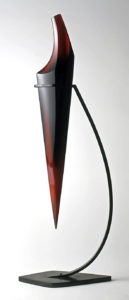
The dynamic relationship between antithetical elements, a fundamental and recurring component of his poetics, is present already in these works, enabling a number of dualistic associations: glass and iron, fragility and resistance, transparency and opacity, mobility and stasis, activity and passivity. This relationship determines those “tensions” – at times implicit, at others explicit – running through his practice, in which a sensory interest in form and the expressive power of material is never disconnected from the symbolic and metaphoric aspects. In concert with the balanced and meditated definition of these first sculptural works – both essential and evocative – is a profound understanding of the intrinsic properties of glass.

The artist is well acquainted with this material and its various effects, possibilities, and production techniques. Iron structures suspend or halt glass blades, accentuating the sense of mobility, “contingency” and fragility (Blade, 1999). Transparent glass wedges rip open immobile iron surfaces. Through their luminous reflections, they project themselves beyond their own formal limits, expanding in space and tending to dematerialize matter itself (Enlightenments). Splitting space, ripping through the darkness of metal to introduce light through the transparency and purity of glass, these sculptures not only correspond to an investigation of an aesthetic nature, but also an ethical one.
They express a need to “clarify”, a will for discernment, and a liberation from the heaviness/oppression of the indistinct and confused. In some ways, the search for a charge from the materials comes close to an Arte Povera-like sensibility, yet Morucchio channels this potential into rigorous and determinate forms produced with extreme precision. His long and complex process of elaboration does not reduce or eliminate the soul, rather, it seems almost to condense or to “protect” it. Thus begins a “catalogue” of almost archetypal, sacred or ritual images of strong semantic valences.

They are bearers of a continuous confrontation of forces: from the luminous trajectories of the crystal wedges of the Enlightenments sculptures to the blades of glass frozen in their forward thrust by barriers of metal (Wave, 2001), to the levigated bundles of sandblasted javelins held together by the “constriction”of strips of inner tubes (Accumulo, 2002). Interest in a development of form and matter in space – clearly identifiable in the Enlightenment series – continues through the environmental interventions produced in 2002 at the Chiostri di San Pietro in Reggio Emilia and in 2003 in Australia at the Royal Botanical Gardens in Hobart. In fact, Percer-Voir seems to be the “environmental” evolution of the first sculptural attempts combined with an intensified search for a vaster sensorial and perceptive space that is always more interactive with the observer. The repeated choice of glass, characterizing this phase of the artist’s production, is determined by the specific properties of the material: transparency and the effects of dematerialization and dynamization caused by reflections. In fact, the title Percer-Voir, playing on the terms perceive, pierce, and see, reintroduces the linguistic, aesthetic, and ethical need to open up new possibilities of perception, of understanding, and of discerning beyond visual, sensorial or intellectual habits. Thus, an investigation that tends to cross the most diverse forms of appearance or habit continues. Inserting a series of crystal glass spikes into a field or onto the mirrored surface of a lake, the artist uses natural reflections of light – and of water – on the vitreous matter in order to generate new contexts of experience, developing the emotional and perceptive qualities of the substance, “opening” the observer’s field of vision to another experience of the space.

The use of critical, political and social languages precisely constitutes one of the main nodes of his eclectic practice: from references to terrorist-like “supreme sacrifices”, inherent in the audio-visual installation Le Nostre Idee Vinceranno (2002), produced for the Sala Rossa of Venice’s Museo Mocenigo, to the light installation Pulse Red (Punta della Dogana, Venice), alarm warning against the risks of congestion of mass-media information, from the complex Australian multimedia work Eidetic Bush, to Laudes Regiae (2007), an installation conceived for the ex Convento dei Santi Cosma e Damiano on the Giudecca island.

In Le Nostre Idee Vinceranno Morucchio draws inspiration from an 18th century painting conserved in Palazzo Mocenigo, representing the heroic act of Capitano da Mar Zaccaria Mocenigo who decided to explode his ship, sacrificing his own life and that of his crew rather than surrender to the enemy.Extrapolating a sequence of photographic frames of the victims’ bodies from the painting, he develops a video where they are enlarged yet reduced to simple silhouettes projected around the original image. Amongst the lilies of the wall brocade, the inconsistent outlines of the “sacrificed” appear and dissolve to the rhythm of Luigi Nono’s chorus Il Canto Sospeso – inspired by the letter of a man condemned to death for resisting Nazi-Fascism. They are swept into the whirlwind of a sea reddened with Macbeth-like dramatic flavour, of “blood that calls out for blood”.

With Eidetic Bush (2003), produced during his residency at the Tasmanian School of Art in Hobart, Australia, he touches on one of the region’s most pressing problems – the massive destruction of the wooded areas caused by the effects of global warming and the devastating practices of deforestation. Through their spectral chromatic abatement, the abandoned scenarios of the blazed woods of Tasmania become the sites of a complex process uniting performance and digital operations. Morucchio’s interventions in the bush seem capable of reactivating the power of imagination.The marks engraved into the bark and the spirals of clay modeled on the burnt trunks appear like elements of a re-appropriation rite – a re-appropriation of the possibility of existing and imagining again. They present the possibility of “rewriting” one’s own existential perimeters in a space where combustion has cancelled out memory – thus, space and time – following a devastation which inevitably alludes to that inflicted by Western people on the aborigine population, pillaged of the territory so inextricably linked to their culture, and therefore completely cancelled. In the video projections, the engraved or clay spirals combine with other digitally constructed ones, appearing and disappearing to the rhythm of Nono’s Caminantes…Ayacucho.

The observer truly seems to enter a mysterious eidetic space, where the “revolt” of a distant memory is reactivated and the first signs of a lost spirituality are rewritten. The ability to relate and dialogue with the preexisting – be it a place, a historical testimony or a work of art – is at the origin of the majority of Morucchio’s practice.Not dissimilar to Eidetic Bush, is the public art intervention Pulse Red (2004), in which the artist interacts with the architecture, the history and the meaning of a site-symbol of Venice – the Punta della Dogana over St. Mark’s Basin. Through a minimal deployment of means, he achieves results of strong scenic impact and transforms the symbolic significance of the place into its semantic modernization. For various nights, the Golden Globe of the Punta della Dogana pulsed with a red light, transforming the historic node along the trade route of goods and information into an alarm, that is, into a signal of the collapse of a mass media communications system which, through its pulsing, signaled its own implosion, while seemingly suffocating any kind of intelligibility. The oscillation between different expressive means seems, at times, to insert itself into a process of creation of different programs. These progressively overlap to develop into works of complex design. Such is the case of two solo shows, Emerging Code at Despard Gallery, Hobart and Emerging Code at Galerie Rossella Junck – born from the interaction between sculpture and photography. Conceived in 2006, its prodromes rest in a photographic work produced in 1994 for the Gipsoteca di Possagno (Gipsoteca). A long meditation on Canova’s oeuvre, particularly the plaster works, led Morucchio to an aniconic interpretation of these same subjects.

The artist concentrates on the points de repère – the means of codification for the transformation of balance and ideal beauty into marble. These points are isolated and developed into the form of round-tipped glass tiles, becoming the base modules for sculptures that are rigorously geometric (Cross Shoots, 2005) or ironically allusive (B[æd] Time, 2009), as well as the constituent elements of more complex sculptural works (Off Shoots, 2006). Emerging Code is based on the interaction between the sculptures from the Off Shoots series, where the artist’s most frequently used materials – glass and iron – return in a completely personal interpretation of Canova’s callimetry. In this work, the photographic details of the plaster models are digitally manipulated and printed onto silver film (Emerging, 2006).

The torsos of the wrestlers Creugante and Damosseno are reddened, emphasizing the contraction of their muscles, thus igniting with a never before seen sensuality. Simultaneously, the extrapolated and isolated masses seem almost introduced to an abstracting process, to which these exponents of the limits of Canovian idealization radically participate until the figurative disappears, leaving only the extreme minimal and aniconic reduction of the plaster models. Here, the points de repère, translated into red-orange glass tiles, remain to condense a sort of generative heat – a luminous pulsating power that opens up and overflows, deforming the opaque iron surfaces. The torso returns in the video-performance Sri Yantra (2008), almost like a development in stages: from photography to sculpture, then from sculpture to performance. Using the same frame of the photographs, the artist’s torso is recorded as he inhales and exhales to the rhythm of a Tibetan mantra of disarticulated polyphony. The discourse frequently addressed in his work, through a dualistic view based on antinomic forces and the ambivalence of messages, is rediscovered and exceeded in a synthesis and reunification of likes and opposites: inhalation and exhalation, masculine and feminine, form and inform.

Through respiration, the body becomes elastic matter in transformation, spilling over its own limits and losing anatomical barriers: from the division of opposites to the unifying one, returning, perhaps, to a primordial androgyny. The dialogue with Canova’s works triggered the photographic series The Main Show (2005), in which the artist addresses spectacularization in the Catholic religion through a sequence of photo frames of the Pietà plaster model.

The sculptural group is photographed from slightly different angles in each shot and the close-up horizontal arrangement of the black and white images reproduces the effect of a cinema sequence, restricting the frame around the emotional centre of the composition, thus emphasizing the drama of the subject that is, in fact, “staged”. A formation of red frosted blown-glass helmets, produced from the mould of a 14th century sparrow-beaked celata, is arranged on the floor of the hall of the Venetian monastery, as the Laudes Regiae – the incoronation mass chorus from the Bamberg Manuscript (11th century) – plays. The reduced profiles of the Passauer Wolf – emblazoned onto medieval swords – pulsate intermittently on the wall before the helmets. The wolf alludes to man’s threat to mankind – that seemingly never satisfied instinct to overwhelm and suppress, which makes man oppressor and executioner of himself (homo homini lupus) – throughout the continuity of time and over eternally repeating history.

This last attribute is also dealt with in the audio-video projection Verso il Paese dei Fumi e delle Urla, produced in Venice in 2008 for Holocaust Memorial Day. Dozens of images of the symbols sewn onto clothing to mark Nazi concentration camp interns – Jews, homosexuals, gypsies, prostitutes, Communists – were projected onto the façade of a building in the heart of the city. The six-pointed stars and the different coloured isosceles triangle were reproduced in detail and assembled to recompose an atrocious atlas of the inhumane, of discrimination, and of violence, to the sound of passages from Nono’s Die Ermittlung. Far from the black and white images of historical memory, this patchwork of cloth presents colours, embroideries and weaves that deceives. Appearing almost innocuous at first glance, they fascinate and intrigue, just as xenophobia and discrimination continue to exist and increase in appeal. Particularly in his video works, Morucchio analyzes themes of a strictly social and political nature.

At heart are the urgent issues addressed and, for the artist, video seems to be the most incisive and direct medium: from Sabato Italiano (2004) to Talk Show (2005) – consists of the editing together of footage of a discussion amongst a group of activists and artists which took place within the Municipal Greenhouse of the Giardini of Castello, which had just several hours before been occupied and assigned as the operating and exhibiting base of the “artistic resistance workshop” Mars Pavilion, project curated by Morucchio himself to Tracciati esistenziali (2008) – articulated through the movement of a group of ants used as a metaphor for our thoughtless and hetero-directional paths of existence. Photography remains a fundamental expressive means throughout the artist’s research, both in its connection with other linguistic dimensions, for example in its relationship with sculpture (Emerging Code), as well as in a strictly autonomous sense.
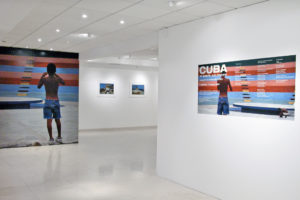
A large part of Morucchio’s work, from the 1990s onward, belongs to the latter category, stemming from long and repeated stays in Cuba, Nepal and other places closer to home. His ability to enter into total empathy with different contexts permits him and his lens to introduce a sort of narration, of which the still frame opens up to other real or imaginary, possible or impossible stories. All the same, it is never a total “abandon” to the subject, but always an assembly of emotions and conscience, of inside and out. It is always a direct perception of what happens and a rigorous framing of a moment.The strong sense of composition derives from this: the formal and semantic structure of every image, the “narrative structure”, connecting the “signs” and returning to them the possibility of a tale. The compositional precision, the visual organization, and the strong sense of colour, be it in an emotional or a structural sense, frequently leads to works of an almost pictorial formulation. However, these never lose that fundamental quality of photography – the indexical nature – which Morucchio takes on in a total and absolute way in relation to experience and reality. With his impressive solo photo exhibition Cuba, a People, a Nation, Morucchio achieved extraordinary public success. The show takes centre stage within the exhibition halls of the Candiani Cultural Centre, portrayed in its versatile and complex daily life by Andrea Morucchio, who visited the island for a prolonged period of time in 1995.
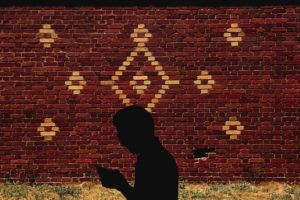
With an acute and astonished eye, he registers the stuff of daily life. He captures gazes that pierce the distance between the subject and the lens – gazes that unknowingly tell of fragments of lives. Or rather, he freezes situations on the limit of the real, or registers the silent metaphysical stasis of solitary objects and architecture within the scenarios of the urban theatre. The formal and compositional aspects are never disconnected from the content and from the emotional participation of the subject, whether it is a place, an event, a person or a work of art, as in Gypsoteca . In this photographic series, realized in 1994 at the Canova plaster sculptures Museum in Possagno the concentration on sculptural values and the formal relationship between the parts, achieved through measured doses of light and shade, are united by an emotional interpretation of the sculpture itself. Like a slow motion vision, in fact, through the succession of takes based on a progressive gap between frames, the artist manages to concentrate on the emotional and structural “nodes” of his subjects, emphasizing the state of desperation, pain, complicity, and harmony – from the Pietà to Le Grazie, to the Amore e Psiche stanti.
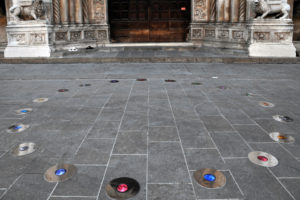
Likewise, by means of a sapient use of perspective, he establishes new links and relationships between the sculptures, held tight within the invisible mesh of an alienating silence made of imperceptible dialogues. Andrea Morucchio’s “Moon landing” occurred in San Lorenzo Square in Vicenza on July 20, 2009 with his installation Disco Moon, in homage to the 40th anniversary of the first landing on the moon where the artist takes up the theme of “space” in a modern context.The nineteen circular elements which reproduce just as many images of the lunar hemisphere are placed in a radial pattern in front of the cathedral’s portal with the intent of creating a “magic circle” which ideally outlines the relationship between the past and the future and determines the boundary between the finite and the infinite. It is up to the passers-by, actors and spectators of the performance to go beyond this boundary. In the dialogue between the work and its artist, it seems clear that the public plays an active role, not as passive receivers but in a collaboration that often becomes part of the artist’s action. In this specific case, the people who pass by become an element of the installation themselves and change its development.
2010 - 2014
Andrea Morucchio is a polyhedric artist and his artistic vision takes in various expressive languages which determine the development of an interior journey that is in precarious relationship to itself. This can be seen particularly in the show Back in Black which “invades” – with its spectacular physicality – an entire room of the International Art Gallery of Ca’ Pesaro in Venice in September 2011. Laid out like an alchemist’s room, a laboratory of experiments, but also a place of personal investigation of identity, the show becomes the mirror where a type of impossible space of reflections resides. The dominance of black which is used in the different materials by Morucchio is the colour/non-colour of an analysis which seems to dissolve, and which then refracts and proliferates in the different figures that it goes through.

Here the artist is certainly the artifex of an inner metamorphosis which shifts every degree of interpretation of the work towards the limits of the absolute, and the austere shapes of his sculptures recall the physical suffering of man who is fleeing from himself in different projections of other forms of himself, and which are just as equally disturbing. The labyrinths, whether real or imaginary, of this fleeing perspective leads to the vertiginous border of the infinite and the synthesis of this journey is completely written on the body of the artist which shows – and at the same time demonstrates – his vulnerability in the video that accompanies and dominates an entire wall of the room. In order to get an in-depth idea of the themes of this significant visual experience by Andrea Morucchio I wish to recall the precise text of Stefania Portinari published in the show’s catalogue, where the writing of the author identifies the determining lines of this experience that blend the artist’s physicality and spirituality. I feel that it is necessary to add that all the metaphors, shadows, tropes and symbols brought together in the visual imagination of this work, makes it almost seem that Morucchio has finally found his real identity, but in reaching the point where all the lines tend to lead to, he seems to lose himself eternally. Rivoluzioni, which is more similar to the experience of video art, tends to infringe upon the pre-established scheme of the visual image in a type of sensorial transfer that involves elements of spectacularity, to bring about a philosophical/existential reflection. The mis-en-scene of this exhibition, which took place at Palazzo Bembo in 2012, is the synthesis of a long introspective journey that Morucchio reveals with his fascination of a place that is darkness and light at the same time.

The sense of suspended time and space of the image allows the artist to confront himself in a claustrophobic dimension where the protagonist is seen in a series of related actions. The sound and images are a complement to the gesture: the broken staff that lies on the ground in the middle of the room is the same one that Morucchio is twirling around in the video projected on a large screen that dominates the room. Giving off reflections and reflecting itself in a the wave-like movement of this gesture is the hypnotic action that the artist reclaims in order explore the shadows in all their nooks and crannies, the hidden areas and secrets of existence. The “tuning fork” which seeks harmony between space and reality in the vertigo of that movement and in the traced out signs – like a mantra – on the body of the artist, almost as if to invoke a sort of purification in the classic perfection of shapes. The invitation to participate in 2012 at the 13th edition of Documenta allowed Morucchio to conceive of a regeneration of the large-scale audio-visual fresco made in 2003 for the Plimsoll Gallery in Hobart, Australia.

Eidetic Bush (2012) in form of documentation was invited to exhibit by the Critical Art project at the thirteenth edition of Documenta for a day. It’s a voyage within the destruction of the Australian forests caused by fires that occurred during the summer of that year. In this, his way of proceeding, in the desolation of the ravaged landscape, the artist impresses his own vital sign on the bark of the trees to declare a reconciliation between man and nature. In the version at Kassel, invited the work takes on the form of a document of memory, no longer as a voyage in the Dantesque circles of hell of his Australian experience, but rather here it is a memento of the enormous shipwreck of history where only the bare wreckage remains. The video, which is located in the Hauptbahnhof in the asceptic context of a place/non-place, recoups the distance of time and reinstates fragments of a humanity which has lost every value of existence in that ineffable blaze that cancels out all traces of the past and any possible future. Identity and otherness are two elements constantly at play in Andrea Morucchio’s work and the environmental context of site-specific work favours the plan itself and it’s conceptual nature. This is the case with Play God (2014) an installation created specifically for the Oratory of San Ludivico Church in Venice in May 2014, where the artist takes up some of the basic ideas of his artistic career and develops them inside the allure of a holy space that transmits a sense of mysticism. The video, placed like an altar pole within a niche, is at the same time is split apart on the facing wall, in a sort of reflection on very extreme opposites, thereby suggesting a parallel vision. The body of the artist, (once again it is the artist’s own body) is protrayed from behind while he moves his arms rhythmically in a repeated action that turns into the perpetual ritual of an exercise which leads to contemplation and meditation.

For the framework of the video, Morucchio chose a geometric pattern by Frank Stella from his 1967 Black series, so as to reaffirm the geometric order of the universe. In this binary logic of repetition a musical theme is introduced by wind instruments that are played using the technique of circular breathing – with no pauses – like the lack of pauses in the movement of the body in the videos. Accompanying the two projections – which are the absolute main features of the installation – there is also a dimension of a sensorial atmosphere which rests on the carpet/hallway/river and links the altar to the opposite wall, a journey to be followed, a departure point towards reconciliation. And then suddenly there is momentary freeze for about a minute and a half that is suspended in the reflection and takes over so that everything really stops: sound, light and action, so that the only thing remaining is the tactile sensation of the carpet under one’s feet and the enclosing consolatary darkness: disturbing as a shroud, comforting as a prayer. And once again there is the “doubling up” effect, and this obsessive symbol of a research that leads the artist to an unceasing analysis of himself brings him to a betrayal of appearances, so as to confirm the ephemeral of a different “I” that is purified and therefore improved and capable of re-establishing a relationship with the outside world which is more protected and less exposed to conflict.

Here, the eye of the viewer is capable of penetrating into the mind and soul of the artist, but in the mystery of every possible interpretation Laing’s doubt remains: “My neck is on the guillotine / the blade comes down / my head goes this way the rest goes that / which side will I be on?” Taking up sunnier and environmentally-based themes, Andrea Morucchio creates a survey of the requalified lands lying between San Dona’ di Piave and Torre di Mosto. Terre in vista (Lands in Sight) is an installation commissioned to the artist by the Museo del Paessaggio in Torre di Mosto and consists of eight photographic panels which extend 16 metres in length by 1.2 metres and which are positioned along the front of the facade at a height of 5 metres, acting as an artistic outer door of the Museum. Andrea Morucchio’s viewpoint is a precise examination that begins from the land – flooring, ground, base – of every physical experience of man, and then focuses attention on the particular and on the basest of vital processes that natural reveals. The results of a lengthy and patient research that the artist created in almost a year of “stakeouts” of the land in order to show the traces of the numerous transformation that have taken place in the course of the seasons and of the signs of time, Terre in Vista is a mosaic that creates the allure of a natural and artifical carpet. Here the photography becomes just the initial element from which a more complex and articulated artistic process develops regarding the seasons and the permanance of place. The final result reveals a visual rhythm that recalls the abstract and spatial art of painting, which inform the matrix of the artist’s cultural journey. Giorgio Baldo, the curator of the project, himself traces out its context and underlines the visionary aspects: “…Morucchio has recognized, in the folly of the analytical photographic eye, which would like to comprehend and classify all the particular details of the earth (and lose itself in the detail), the outlines of a few figures. He has referred to these great restrictive boundaries, as certainties of the ‘true’ vision; attempting to give substance to the geometric genius inherent inside them, by orchestrating signs, space, colour and motion…”

Again in 2014, Andrea Morucchio also participated in a group photography show on the theme of urban images in dialogue with contemporaneity. The show IMmAGINE, at the Michela Rizzo Gallery in Venice, brings together the viewpoints of several important photographers who investigate the landscape and contemporary architecture. Hamish Fulton, Mauro Ghiglione, Francesco Jodice and Andrea Morucchio show their personal visual journeys which wind their ways through places of their daily lives that move on to an exploration of the reality of environmental and industrial landscapes.In this show, Morucchio conducts his itinerary in the outskirts and “no-progress” areas of the city, in order to see the actual state of abandonment of the land personally. The perspective that the artist uses to record these places does not start from seductive aesthetics of the image, but rather, he tries to go beyond this, for a vertical point of view, in an attempt to travel through the obstacles of reality and move beyond, towards a more open and freer horizon. His photographs are incisive tools of research that distinguish, clarify, contrast and establish relationships and that plumb the depths of reality.
2015 - 2024
In concomitance with the 56th International Exhibition of Art at the Venice Biennial, Andrea Morucchio presented his work The Rape of Venice, at Palazzo Mocenigno Museum, a project for MUVE Contemporaneo. Here the artist returns to the the language of a multimedial and sensorial installation to make the public aware of the subject of protecting Venice. In one of the Museum’s rooms, renamed the White Room, Morucchio laid out a carpet made from the reproduction of scattered pieces of the mosaics present in the Basilica of Saint Mark. An environment of sound is created from underwater sounds mixed together with the noise of swimmers crossing the Canal Grande, while headlines from the international press that denounce the situation of the city’s visible urban decay appear on the screen.
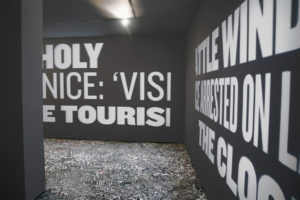
This is certainly a socio-political work that aims at criticizing the problems of Venice concerning the overcrowded conditions caused by the presence of tourists and the consequent decay that ensues. The sensorial journey that the artist proposes within the artificial reality of this reconstruction provokes a momentary sense of loss and a visual change that determines a conscientious awareness of the extremely alarming conditions. All of the spectator’s five senses come into play from a series of perceptions that change the focus of attention and make it veer off into a precarious state of balance oscillating between shock and hope. The scent of frozen algae – “a sensation of supreme bliss” and a “synonym of happiness” according to the writer Joseph Brodsky – that envelops the room is the key to an alchemical cleaning process that aims at re-establishing the climate provoked by the negativity of the images on the screen. In his ethical journey, Morucchio also takes up the theme of immigration with the same poetical philosophy and signs that have always distinguished his work. It is in Red Track, (2016) the 2003 performance created in Puglia where the artist explores the suffering of those who are forced to leave their native land. The events are narrated in an emblematic video that Morucchio put together with a gaze directed at the drama of the situation, without any type of mediation and always with a poetically poignant tension that brings the individual to the foreground. A man of colour is filmed walking under sun while carrying a sack of jute that leaves a line of red earth, therby marking out his path.

It is the red line that reconnects him to his native land like holy scripture with no words as he moves forward, leaving behind all the exasperation and pain which his story recounts.The video was presented in the rooms of Palazzo Mora, as part of the Venice International Performance Art Week in December, 2016, and it provides testimony to an analytical process that the artist is carrying out in the search for inner truth and which is to be found in the gesture of a consolatory act of redress. So once again, the artist is putting himself in the centre, along with his thoughts and his ideas, but once again it is not possible to define him, impose contents upon him, close him up in a formula, because any definition that seems to express something about him is immediately contradicted. Every one of his works represents an absolute innovation, because the point of view is radically silenced, as is his concept of the world and style. Andrea Morucchio relies on reason for tools to express this concept and his vision of humanity is desperately romantic: “So long as we feel well, we do not exist” says Cioran, and this is why the artist challenges himself: to unload the tension in a metaphysical flash of memory, in that very profound stillness that separates doubt from truth. The MUPA, the Museum of Landscape in Torre di Mosto has hosted from 2015 various types of works by the Venetian artist in various prestigious group shows including different media: digital art, sculpture, the permanent installation Terre in Vista, which surmounts the entrance to the Museum since 2014, and the solo photographic exhibition Fermo Immagine / Still Picture (2017); “Pure” photography, in this case industrial photography, regularly returns to Morucchio’s research and artistic path. “The vision of the industrial landscape of Marghera that Morucchio presents is that of a timeless place, a container without “content”, a hypothesis of an unreal landscape or the possible “set” for the setting of new apocalyptic scenarios.” (Stefano Cecchetto)
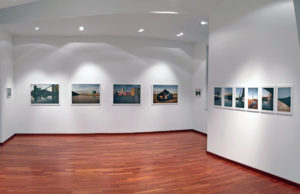
“An industrial landscape intended as a repository of cultural, historical, human, physical and material archeologies. Morucchio draws inspiration from its aesthetic and enigmatic nature to redesign its visual, anthropological identity as the body of the image itself. Isolation, spectrality and estrangement become figurative formants and critical intervention on the phenomenology of the “non-place”. An industrial landscape interpreted by Morucchio as “lieu de mémoire”, in which the experience of the place becomes an uncommon depth, therefore private, and in which the conjunction between differences and repetitions plays with the appearance of a distance, or the symptom of the visual. In Morucchio’s photographic sequences, it turns out that the spaces between the images, -the interstices-, are not limited to an inert role of separation, but become an interzone where hybridization is a semantic investment: memory and the unconscious, the polysemy of times and spaces, the abstraction and ambiguity of the place, the rhythms and silences, isolation and alter-reality. An unreal and metaphysical atmosphere in which he finds himself immersed, and which becomes a stimulus and a key to interpret the territory photographically, bringing out a new vision of reality that elevates the “non-place” of an industrial area to a place with a full and intelligible identity. ” (Laura Cornejo Brugués)
Since 2015 Morucchio creates a series of digital works entitled Puzzling composed of thousands photographic “tiles” reproducing parts of the mosaic flooring of the Basilica of San Marco in Venice. The same tiles were used, randomly arranged by Morucchio, to create the flooring for the installation The Rape of Venice at Museum of Palazzo Mocenigo. Geometric, phytomorphic and zoomorphic motifs are repositioned and ordered to reinterpret a selection of paintings by masters of the past looking for a point of contact, an encounter with the great painting of the Renaissance in order to verify the existence of a relationship with art of the past.
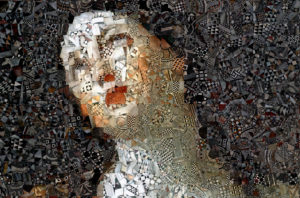
The “iconic” images from Renaissance painting, that are individuated by Morucchio, are then re-elaborated in a process of chromatic fragmentation which declares its identity; they become decomposed visions and they are restituted in fragile chipped elements, like pieces of memory that return after a deleterious explosion. The time and space of this restitution comes about all within the modern concept of the pixel, a elaboration tool of the sensitive data of the images. But the characteristics that govern this singular ars combinatoria are generated by the personal poetics of the artist who is able to fuse different concepts and arrange them into solutions and models of a rare aesthetic refinement. From Leonardo to Botticelli, from Giorgione to Titian which all enter into the halls of suggestions with an ideological slant, with the stereotype of already worn out images of aesthetic consumerism, and thereby easily interpretable by the larger public. Morucchio’s distinction lies is his ability to bring these references into a different type of interpretative philosophy which interrupts the temporal circle to open up towards the ever wider territories of modern language. On the occasion of the solo exhibition Puzzling, the Image is Other, also (2019) at Galleria l’Occhio, Venezia, in collaboration with Bugno Art Gallery, Morucchio’s Puzzling Project is enriched with a new series of works entitled Puzzling Pop; instead of the tiles that reproduce the floor of the Basilica of San Marco the artist has collected thousands of images of butterfly wings that he uses to revisit a selection of works by Andy Warhol. The development of the Puzzling project in reinterpreting subjects of Renaissance pictorial art has stimulated Morucchio to expand the range of action by confronting the artistic movement which, since the end of the 1950s, has introduced a new figuration and first investigated the standardized and standardizing communication system of the nascent consumer society.
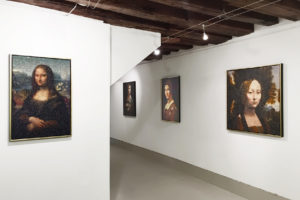
“From being merely quotations, the “figures” taken in a targeted pose by the artist, are presented in such a way as to unhinge and trap the alleged perceptual certainties; they are rather duplicate images, or rather bi-frontal or, better, multi-dimensional, for which the viewer’s gaze is enticed, remains “entangled”, thus attracted into the “network” of their factual chains of structuring and signification. From this arises the complexity of resonances and references set in these mirror-images (not unlike the neuronal ones) and this function, if we look carefully, even revealing the archetypical semblance of the hermaphrodite hidden in the enchanting female portraits of Leonardo and of the commodified and regressive polysemy pertaining to certain mass “myths” obsessively anticipated and exalted by Warhol.” (Toni Toniato)
Engagement Acts is a video installation presented for the group show The Scent of Time in Venice in 2019 for the first edition of Majhi International Art Residency organized by Durjoy Bangladesh Foundation in collaboration with Lightbox and later in the same year in Dhaka supported by the Embassy of Italy for the 15th Italian La Giornata del Contemporaneo / Contemporary Art Day by AMACI. It consists of a series of videos documenting the artist’s actions created in a desolate, barren seascape; a specific alienating atmosphere from control shots, to significant contrasts and to a limited color spectrum. These are actions in which Morucchio interacts with the elements of this environment: tree trunks, rocks and sand; cathartic actions, liberating vent but also manifestations of an instinctual and primitive expression of creativity – rituality that over the years has characterized some of Morucchio’s installation projects.
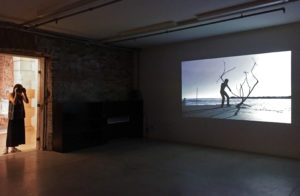
“The romantic idea of Nature disappears completely, the anthropocentric vision of man that modifies the environment at will seems to implode in itself, leaving space to the environment itself and to the ecological intelligence of the contemporary artist who intervenes in an apparently meaningless way; the deep understanding of the environment itself and the relationship that can be established or not with it can only take place through endless attempts and continuous failures, both psychic, physical and conceptual.” (Andrea Pagnes) Laura Amman, who followed the artists during the preparation of the works for the Scent of Time project writes: “Engagement Acts shows Morucchio in a sandy landscape engaging in a series of bodily explorations of his surrounding – throwing and escalating rocks and bush branches, experimenting with the ability of his body of passing through the natural obstacles he encounters. In a natural way, he experiments with nature’s force and power and explores to what extend it is possible to achieve a graceful result. He is the sole explorer of this empty scenery, which is meant to be “everywhere and nowhere,” since it is not possible to identify from the landscape only where the action actually takes place. Andrea tells me that the film was made in the Venetian beach area of Lido, but he consciously aimed to a more universal approach. The artist is also the sole explorer in this film because there was no cameraman and production team on site. In some rather funny moments, nature unexpectedly revenged the artist by throwing back at him some object he had thrown first. A metaphor of human action on the environment?”
During the lockdown period caused by the psico pandemic in 2020 Morucchio started the Venezia Anno Zero project video documenting for more than two months most of the areas of Venice. The beauty and spirit of the lagoon city re-emerged from the moment when all the activities related to the mono economy based on the exploitation of mass tourism stopped allowing the city to manifest a poignant and metaphysical beauty. An unprecedented beauty and charm in the history of the lagoon city, the effect of an epochal event on an international scale which in Venice has suddenly reset the evident deleterious effects of its management in the last decades.

So he found himself experiencing this moment of suspension that leads those who despite the restrictions of movement to go through Venice to live an experience that it is not exaggerated to call it dreamlike, sneaking furtively through the streets, having Morucchio deliberately not requested any official permission to go around a city under police control and documenting most of the areas of Venice by collecting a considerable amount of video material using it initially as an online diary on social networks by posting short edited videos reporting the place on the day and time of filming. Subsequently this material has been edited with the collaboration of a contemporary musician to become a video-audio installation. Images were extrapolated from the videos for an editorial project of a photographic book and also to be printed and exhibited as photographic works.“A Venice as you’ve never seen it, suspended between sky and sea and totally deserted for the lockdown. A silent Venice, no longer engulfed by chaos, which finally breathes and returns an unprecedented beauty. Immersed in a timeless atmosphere, full of dreamlike and metaphysical suggestions, it appears as crystallized. Flooded with light and magically sublimated by its own isolation.” (Roberta Vanali). The title Venezia Anno Zero is clearly an evocative quotation of Rossellini’s neo-realistic masterpiece Germania Anno Zero for which the shots are not only poetic but express a vision of the soul of the city and its residual inhabitants from which hopefully you can start a virtuous path that reverses the self-destructive trend that has characterized the history of Venice in recent years.

From November to January 2021 Morucchio participates in the exhibition Beyond the Face, the Contemporary portrait at the Art Centre Les Bernardes in Girona, Spain. The curator Laura Cornejo Brugés reserves an entire room for the works of the Puzzling Pop series, created especially for this exhibition, whose walls have been painted in relation to the colours of the works on display. For this occasion Morucchio also created a video Puzzling Pop video experience – in which the sound part created by the musician Leonardo di Angilla accompanies visitors to the exhibition. The exhibition brings together projects by the artists Andrea Morucchio, Andy Warhol, Olivier de Sagazan and Jordi Abelló, four eclectic sensivities with a recognized trajectory, which with interdisciplinary languages approach in a core of works the genre of contemporary portraiture. Using citation and revisionist strategies, Morucchio operates on Andy Warhol’s famous portraits of media icons, using a digital collage technique – the juxtaposition of photographic fragments of butterfly wings – with which he deconstructs the morphology of the faces. The subjects are given a new visual texture, due to the chromatic alterations and expressive traces of a puzzle that renews their sense of individuality. (Laura Cornejo).

Re-Flooring is an extremely innovative and original project that lasts throughout the 59th Venice Biennale 2022. Starting from the mosaic floor of St. Mark’s Basilica Morucchio elaborates Re-Flooring a AR Augmented Reality site-specific NFT installation project in an evocative space, a church built in the early twentieth century in Romanic style no longer place of worship located on Isola delle Rose in the Venice Lagoon now the site of JW Marriott Venice. The work consists of nine printed panels hanging on the walls of the Church. The different images printed on the single panels reproduce the initial stills of the corresponding video animation. The nine different animations correspond to as many NFTs entitled Re-Flooring nft video. The work is experienced through the use of a free downloadable augmented reality app; the visitors by framing the panels with a smartphone “transform” them through Augmented Reality into monitors that transmit videos with relative sounds.
With the exhibition Puzzling Identities Morucchio “stages” at Bugno Art Gallery in Venice 16 digital works, a complete and comprehensive representation of the three types that characterize or rather determine the Puzzling Project in this case declined to the theme of the portrait: Fantastic Portrait – Puzzling Pop – Puzzling Renaissance. Fantastic Portrait: using a reduced number of butterfly wings photographic tiles the effect is that of a transfiguration of the portrayed subject giving shape to characters vibrant with a positive expressive force and at the same time disturbing as projections of the unconscious. Puzzling Pop works reinterpret some iconic portraits by Andy Warhol.

These works were created for the 2020 show in Girona Beyond the Face: the contemporary portrait. Through augmented reality the visitors enjoy audio video animations that correspond to NFT works connected with the typology of the Puzzling Pop tangible works. Regarding the related NFTs Puzzling Pop _ NFT _ video I used as matrices to rework the same original photos that Andy Warhol used for the creation of his works, Ali, Mao,Marilyn. Puzzling Renaissance works mark the beginning of the Puzzling Project in 2015. These are the previous works created with the digital mosaic technique made up of thousands of photographic tiles of St. Mark’s Basilica mosaic floor. These works were exhibited for 2019 solo show Puzzling. L’immagine è altro, anche. at Galleria L’Occhio, Venice or at 2018 Grand Art Fair Milan and in 2019 at the group show Seen Anything Interesting? Bugno Art Gallery, Venice. Exceptionally at the center of the Gallery is also exhibited Blade n°14, 2012, a particularly significant work in Morucchio’s artistic career as it is from this series of glass and iron sculptures that the Venetian artist in 2000 began his artistic research with his first solo exhibition Dinamiche.

In 2024, to coincide with Morucchio’s solo exhibition The Puzzling Classics Show and the start of the 60th Venice Biennale, the Re-Flooring project is presented again in the spaces of Tesa 2 by _docks_cantieri_cucchini. On this occasion compared to the first installation of Re-Flooring the installation space is completely different; in 2020 in the Rose Island church the set of panels were conceived in order to create a ‘sitespecific installation. With Re-Flooring 2 we find ourselves in a space of a former boatyard and nevertheless the installation elements as a whole dialogue perfectly with this new context giving new meaning and artistic dignity to the repurposing of the multimedia work. At the same time a short distance from Re-Flooring Morucchio in collaboration with Bugno Art Gallery and BDF presents the solo exhibition The Puzzling Classics Show. The exhibition features a selection of works from the Puzzling Renaissance series with reimagined subjects of paintings by Tintoretto, Giampietrino, Titian, Palma the Elder, Veronese, Giorgione, and Leonardo. Among the exhibited works, “La Tempesta,” of a landscape genre, stands out, while the rest belong to the portrait genre. The larger-scale piece, titled “Il Paradiso,” takes on an “installative” dimension, expanding into the surrounding space; six square works placed at various points in the exhibition space, depict characters extrapolated from the main work, adding a layer of depth and engagement to the overall artistic experience.
